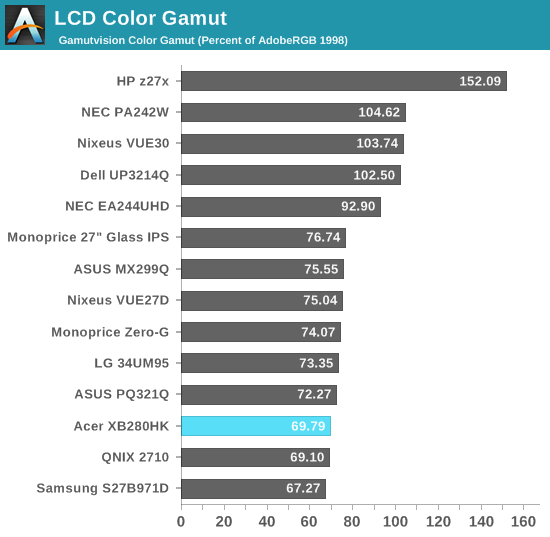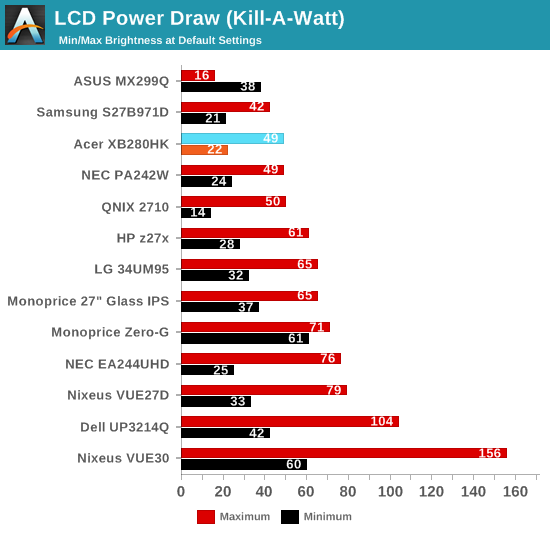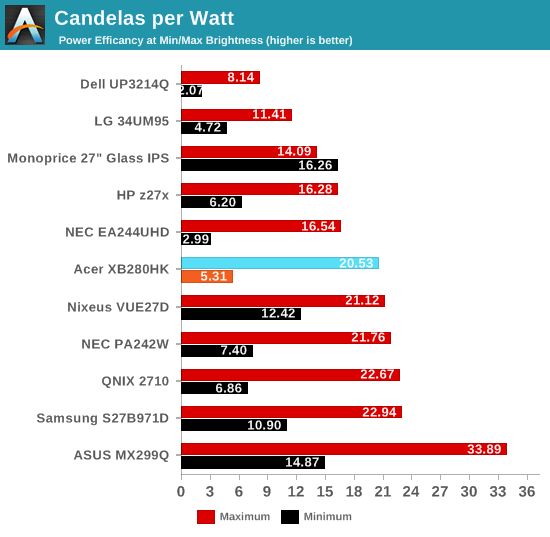Acer XB280HK 4K G-SYNC Monitor Review
by Chris Heinonen & Jarred Walton on January 28, 2015 10:00 AM ESTAcer XB280HK: Input Lag, Gamut, and Power Use
Like the other G-SYNC displays I have tested, the Acer 4K has no inputs aside from a single DisplayPort. Because I have no CRT monitor that can run at the same native resolution as it, nor a DisplayPort compatible lag tester, I can’t produce an accurate input lag measurement for the display. Obviously this is not an ideal result for a gaming display, but any number I could produce I would have zero faith in.
Color gamut shows just under 70% of the AdobeRGB color space, or a bit short of the sRGB gamut. As we saw that red is a bit under-saturated when looking at the CIE diagram, this result comes as no surprise. It’s very close so it won’t be really noticeable, and you likely won’t use the Acer for serious image editing anyway.

With the backlight at maximum on a solid white screen, the Acer consumes 49 watts of power. Set the backlight down to minimum and that falls to only 22 watts. This is well below the other 4K displays we have tested, though those all use IPS panels instead of TN. It also shows that the G-SYNC hardware, at least on these static tests, does not seem to consume a lot of extra power compared to a regular display.












69 Comments
View All Comments
NotLupus - Thursday, January 29, 2015 - link
Get a high-speed camera and test input lag then.AnnonymousCoward - Thursday, January 29, 2015 - link
Yeah. The input activation could be tied to an LED, like caps lock already has, or if a mouse was modified. The camera measures the LED vs on-screen change.AnnonymousCoward - Thursday, January 29, 2015 - link
This Acer is so much fail!-TN at 28" is bad. Angles are inherently a problem.
-4K is too many pixels for today's GPUs.
-They capped framerate to 60Hz. This monitor would be far more interesting if it at least went up to 75Hz, and displayport 1.2 has the bandwidth.
-70% gamut is poor for games.
Older screen tech with Gsync added and a faster tcon would have been better, even if it was simply:
-30" 2560x1600 >90% gamut with Gsync at up to 100Hz.
yefi - Sunday, February 1, 2015 - link
I'd really like to see 30" 1600p monitors with g-sync. Unfortunately today, everything seems to be 1440p or 28" 4k. Whatever happened to vertical height?tsk2k - Friday, January 30, 2015 - link
The real question is where are the god damn oled monitors!?!?!?! LG????anubis44 - Tuesday, February 3, 2015 - link
Another issue for GTX970 users, of course, is that 4K will usually require more than 3.5GB of graphics card memory, which will put their frame rates in the toilet, so paying extra for a 4K G-Sync monitor for these users is adding insult to injury.perpetualdark - Wednesday, February 4, 2015 - link
This article left out the other Acer g-sync option, the $599 XB270H. The downside over the ASUS ROG is it is only 1080, but then I never run anything higher than that in games anyway as it is more than enough resolution for my eyes. Plus you still need a pretty powerful graphics card to run at 1440 reliably. It is $200 less than the swift or the acer 4k. Yes, it is TN, but frankly it is the best looking TN panel I have ever seen, and unless I am trying to game from 10 feet off of center (why on earth would anyone??) it looks perfectly fine. Color is fantastic once I dialed it in a little, and the difference in games is spectacular. runs up to 144hz. Like the ROG swift, you can also choose to run in lightboost mode which makes your LCD look more like a CRT, although G-sync doesn't support lightboost at the same time as g-sync (changing strobe rates to match everything else would be a nightmare). The downside is you have to play a g-sync enabled game. Of course, if it isn't g-sync capable, just turn on lightboost and/or run at 120 or 144hz and you still get far better gaming performance over other monitors.I use an older 660 gtx card, and so far every game I have played pretty much runs liquid smooth at the highest settings. Lately I have been playing World of Tanks, and cranked all the way up, I can spin, zoom, pan, scroll, etc as fast as I want and I have yet to see a hitch or a tear, and I have tried to force it. I can go into the garage and with all those details on, spin my view back and forth as fast as I can whip the mouse back and forth, and no tearing at all. It is fantastic, and to me worth every penny.
I am sure some people will say things like 1080 is way too low of a resolution, or that TN sucks, or that $599 is still too high for a 27", but until something better is out, it is the best 27" gaming monitor you can get for less than $600. Sure, I could have gotten the Swift, but frankly I didn't need 1440 and that extra $200 got me a shiny new Samsung 850 pro ssd, and I am quite happy with it.
looncraz - Thursday, February 5, 2015 - link
"AMD GPUs don’t properly scale the resolution to fill the whole screen"This is a setting, pure and simple.
CCC->My Digital Flat Panels->Properties->Select the proper monitor->Scale image to full panel size
The latest AMD drivers also have "virtual super resolution" which allows you to run any game (or your desktop) at higher resolution than your monitor supports.
I play Battlefield 4 @ 3200x1800 @ 60 FPS - I disabled anti-aliasing and couldn't tell a difference at this scaling (when I could clearly see it - and be annoyed by it - at 1080p).
I will be doing this with every game that supports it now, super awesomeness.
Clorex - Tuesday, February 24, 2015 - link
What is pixel decay?From page 2 of the article:
"while G-SYNC can refresh the panel at rates as low as 30Hz, I find that anything below 40Hz will start to see the pixels on the screen decay, resulting in a slight flicker; hence, the desire to stay above 40 FPS"